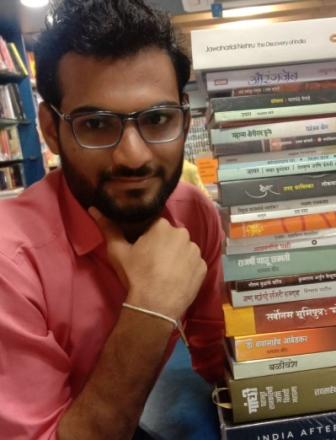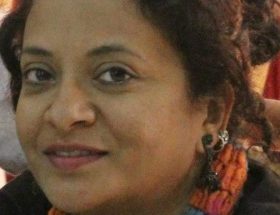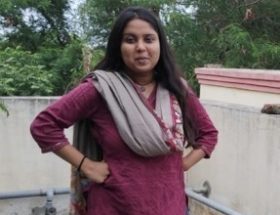Vaibhav Kharat
A song composed or sung on Babasaheb Ambedkar is called Bhimgeet in Marathi and Bhimsongs in English. Bhimgeet, or Bhimsongs, are also known as Jaibhim geet/songs or Ambedkar geet/songs. Ambedkar’s work, his thoughts, his political and social philosophy, and his lived experiences are presented through these songs. Today, thousands of Bhimsongs are available in various languages. Also, thousands of Bhimsongs are composed and sung every year. Bhimsongs are mostly in Marathi, while some are in Hindi, Punjabi, Kannada, and other Indian languages. Many Shaheers (well-known or renowned folk singers), folk poets, and Hindi singers have sung Bhimsongs. Bhimshahir Vamandada Kardak composed more than 10,000 Bhimsongs and sang many. Shahir Bhimrao Kardak (who started Ambedkari jalasa in 1937), Shahir Annabhau Sathe, Shahir Vilas Ghoghare, Prahlad Shinde, Anand Shinde, Milind Shinde, Adarsh Shinde (popularly called Shindeshahi Gharane), Vitthal Umap, Shahir Sambhaji Bhagat, Shahir Kadubai Kharat, Shahir Shital Sathe, and Ginni Mahi are some famous Bhimsong singers. Apart from this, so-called mainstream Savarna singers such as Shankar Mahadevan, Shreya Ghoshal, Shaan, and others have also sung Bhimsongs. These songs are not only played by Ambedkarites folk during social and cultural festivals like Ambedkar Jayanti, Buddha Jayanti, birth anniversaries of Bahujan icons, national days, and personal celebrations like birthdays, marriages, and home inaugurations, but they are also sung and played in their everyday lives when they collectively meet while going to farm or for work in paddy fields as wage labourers, when they travel together as migrant workers, or for marriage. In particular, in Maharastra, based on my 22-year lived experience, I can say that in my home, in my community, and in my locality, no day passes without listening to these songs, which not only tell us our Dalit and Buddhist historical trajectory but also motivate us to assert our identity, to praise our culture, and to manifest our struggle for dignity, upholding the constitutional values and Buddhist philosophy of equality, liberty, fraternity, and social justice.
These types of songs popularly emerged after 1927 during Ambedkar’s temple entry movement in Maharashtra, but we can trace their roots to Dr. Ambedkar’s guru, Mahatma Phule’s ‘Satyashodhak Society’ where ‘Satyashodhak jalsas’ used to take place to spread Phule’s anti-caste philosophy, which were mainly started by Gopalbababa Walangakar (a follower of Mahatma Phule), but Bhimsongs got a wide audience and spread into other parts of India after the 1970s, when the Dalit Panther movement was at its peak and the centre of attraction of all events in Maharashtra, which was influenced by the Black Panther movement of America. As the Ambedkarite Movement spread across the country and became stronger, Bhimsongs were sung in a variety of styles, ranging from Ambedkar jalsas sung by Shahirs to Ambedkar Bhajans sung by local singers, Bhim Palnas sung by women during pregnancy, baby naming ceremonies, or as a lullaby, to Bhim Rap and Dalit pop, which not only praises Dr. Ambedkar but other Bahujan icons like Buddha, Kabir, Ravidas, Tukaram, Shivaji, Periyar,Phule, Kanshiram, Behanji Mayavati, and many others.
Bhimsongs Unveiled: A Tapestry of Popular Culture
The term ‘Bhimsongs’ encapsulates a rich tapestry of popular culture, manifesting itself across various dimensions and echoing the sentiments of folk culture, mass culture, dominant culture, and working-class culture. Raymond Williams’ multifaceted definition of ‘popular’ finds resonance in Bhimsongs, as they are not only well-liked by many but also serve as a cultural expression deliberately crafted to win favor and admiration from a wide audience. In the context of folk culture, Bhimsongs trace their roots to the homogeneous and isolated social groups of Dalits, particularly the Mahar caste, in rural Maharashtra. These songs, emerging after the Mangaon Parishad in 1920, evolved from slogans and praises into a cultural phenomenon, binding Dalits together in their struggle for social justice. Oxford’s definition of folk culture aligns with this narrative, as Bhimsongs originated from relatively small-scale social groups in rural locations, reflecting the authentic culture of the people for the people. Examining Bhimsongs through the lens of mass culture, John Storey’s definition resonates strongly. Initially limited to the movement level and rural areas, Bhimsongs gained momentum after the 1970s with the emergence of the Dalit Panther organization.
The songs, once confined to local performances, became mass-produced cultural products disseminated widely through various media channels. The commercialization of Bhimsongs after the 1990s, with recordings, CDs, and DVDs, transformed them into a significant mass industry, demonstrating their evolution into a formidable aspect of popular culture. As for dominant culture, Bhimsongs have become a powerful force in shaping the sociopolitical landscape of Maharashtra. With the significant numerical strength of Dalit communities, particularly the Mahar caste, these songs serve as a unifying cultural force. They assert the collective identity of the marginalized and have transcended geographical boundaries, becoming a dominant cultural force even in the diaspora. Bhimsongs have played a crucial role in asserting the cultural dominance of the Dalit community, challenging existing power structures, and becoming both a dominant and emergent cultural force. Finally, Bhimsongs delve into the realm of working-class culture, reflecting the transformative journey of Dr. B.R. Ambedkar. Rooted in the cultural narrative of Maharashtra, these songs echo Ambedkar’s commitment to the working class. From his involvement in labor movements during the Great Bombay textile strike to his significant legislative contributions as the de facto labor minister, Ambedkar’s legacy in the realm of labor is integral to Bhimsongs. These songs serve as a poignant reminder of Ambedkar’s dedication to the upliftment of the working class, making Bhimsongs an indelible part of Maharashtra’s working-class culture. So in this way, Bhimsongs, with their multifaceted expressions, embody popular culture across folk, mass, dominant, and working-class dimensions, reflecting the diverse facets of Dr. B.R. Ambedkar’s legacy and the ongoing struggle for social justice.
Bhimsongs: Resonating Dalit Assertion and Celebration
The significance of Bhimsongs in the everyday lives of Dalit people in Maharashtra is profound, encapsulating cultural resilience, social empowerment, and a continuous quest for justice. Bhimsongs, named after the iconic figure B. R. Ambedkar, have evolved into a cultural phenomenon that goes beyond mere musical expression, playing a pivotal role in shaping the identity and consciousness of the Dalit community. At their core, Bhimsongs serve as a powerful form of cultural expression, allowing Dalit individuals to articulate their experiences, struggles, and aspirations through music. Rooted in the historical context of caste-based discrimination and social injustice, these songs become a medium through which the Dalit community narrates its own story. The lyrics often draw inspiration from the life and teachings of Dr. B. R. Ambedkar, celebrating his vision of social equality, justice, and empowerment. In the everyday lives of Dalit people, Bhimsongs hold a dual role—one of resistance and the other of celebration. They resist the historical marginalization and discrimination faced by the community, providing a platform to voice grievances and demand societal transformation. Simultaneously, these songs celebrate the resilience and strength of the Dalit identity, fostering a sense of pride and unity within the community. which we can see in the following song, sung by Adarsh Shinde in 2013—’Bhima Koregaon Kele Bhima Koregaon’.
‘उसळत्या रक्ताचा पडिला प्रभाव
गाडीली ती पेशवाई केला वरमी घाव
इतिहासात अजरामर शूर महाराचे नाव
भीमा कोरेगाव केले भीमा कोरेगाव’
‘Fallout effect of spurting blood of Mahars
Attacked the Peshwa army to ruin them into soil
In history the name of Mahars will be immortal as valour warriors
Thus happened Bhima Koregaon’
‘ तुच्छ ही जात आहे तुमची अती शुद्राची
आस का धरता तुम्ही अमुच्या कडे मानाची
असला शूद्र तुम्ही, शूर जात ही अमुची
स्वनापारी होत नाही बरोबरी तुमची
अशी कर्मठ त्या कावळ्यांनी बघा केली कावकाव
भीमा कोरेगाव केले भीमा कोरेगाव’
‘Inferior is your caste of untouchables,
Why do you expect from us (Peshwas) that we will respect you?
You are Shudras (slaves), and we are kings and warriors
Even in dreams, you can’t have comparisons with us (Peshwas)
Such was the cawing of these orthodox crows
Thus happened Bhima Koregaon’
This song conveys the assertion and strength of the Mahar caste during the third battle, ‘The Battle of Koregaon’, which took place on January 1, 1818, between the army of Peshwa Baji Rao II and an East India Company force, mainly Mahars, where twenty-eight thousand Peshwas were defeated by Mahar soldiers of the EIC. Mahar soldiers fought against Peshwas as their conditions during the Peshwa rule were horrific and they hadn’t had any natural or civic rights; they used to consider themselves even inferior to animals. As the British came into India and their mobilization started, they felt a sense of existence and solidarity, wanting to prove and assert their identity. There are thousands of these songs on various historical incidents of Mahars, which not only motivate them in their everyday lives to have self-respect but also guide them to have an intact fight against Bramhanism to establish equality, liberty, and fraternity via engaging in the Ambedkarite social justice movement.
Identity and Activism
The socio-political messages embedded in Bhimsongs contribute significantly to the empowerment of Dalit individuals. By addressing issues such as untouchability, social inequality, and the quest for dignity, these songs become a rallying cry for social change. They serve as a reminder of the ongoing struggle for justice while inspiring a collective spirit of resistance and activism. Musically, Bhimsongs bridge the traditional and the contemporary, incorporating elements of folk traditions with modern genres. This fusion not only makes the music culturally rich but also accessible to a broader audience. The rhythmic beats and engaging melodies create a captivating musical experience, making Bhimsongs an integral part of cultural events, protests, and everyday gatherings within the Dalit community. Beyond the cultural and political dimensions, Bhimsongs play a role in fostering a shared identity among Dalit individuals. These songs create a sense of belonging and solidarity, reinforcing the notion that their experiences are not isolated but shared by a community with a rich cultural heritage.
Conclusion
Bhimsongs have a profound impact on the everyday lives of Dalit people in Maharashtra. They serve as a cultural anchor, providing a means of expression, empowerment, and celebration for a community that has historically faced oppression. Through the rhythmic beats and resonant lyrics of Bhimsongs as Ambedkarite culture, the Dalit community continues to assert its identity, demand social justice, and strive for a more inclusive and equitable society.
~
References
1 . Omvedt, Gail. 1994. Dalits and the Democratic Revolution: Dr Ambedkar and the Dalit Movement in Colonial India. New Delhi: Sage Publications
- Sathe Putul . 2021 . Reading Sambhaji Bhagat’s Bhim Geet. Mumbai University.
- Storey, John. (1993). Cultural Theory and Popular Culture: An Introduction. Pearson and Longmannn (chapter 1) .
- Williams, Raymond. (1985). Keywords : a vocabulary of culture and society. (236-8) . New York: Oxford University Press .
- Maitreya, Yogesh. “In the verses of Dalit shahirs, you can hear the history of India’s anti-caste movement”.scroll.in
https://scroll.in/magazine/878456/in-the-verses-of-dalit-shahirs-you-can-hear-the-history-of-indias-anti-caste-movement
- ……………… “Dalit shahirs of Maharashtra: Bhimrao Kardak’s jalsa against caste”.Firstpost.
https://www.firstpost.com/long-reads/dalit-shahirs-of-maharashtra-bhimrao-kardaks-jalsa-against-caste-4479325.html
- https://www.jaybhimlyrics.in/2022/05/bhima-koregaon-song.html
~~~
Vaibhav Kharat, is a graduate in sociology from Fergusson College, Pune, and is currently pursuing MA in Sociology from, the Center for The Study of Social Systems (CSSS ), JNU, New Delhi. He’s active in the Ambedkarite Movement at college and university campuses and has a keen interest in Anti- Caste philosophy, Pragmatism and Feminist Philosophy.










